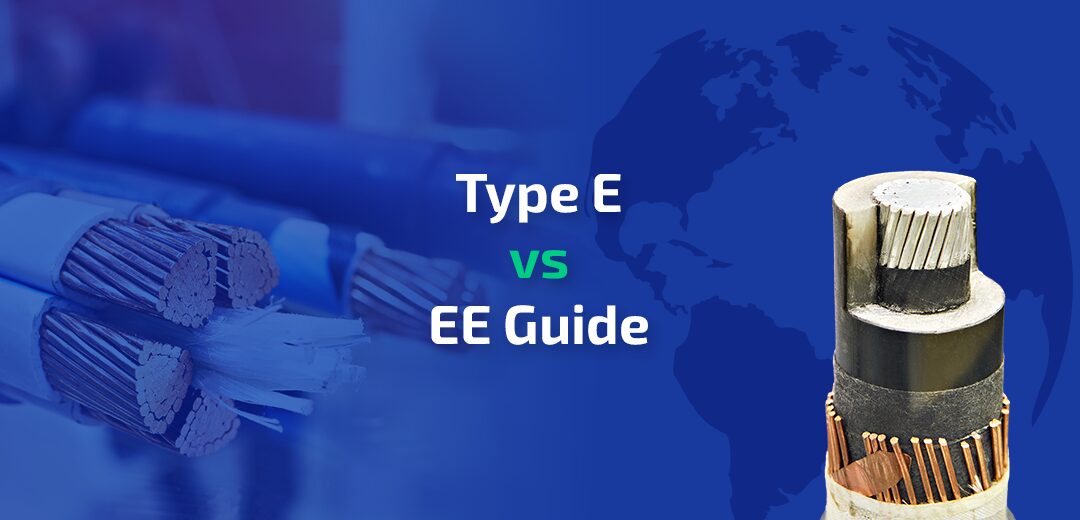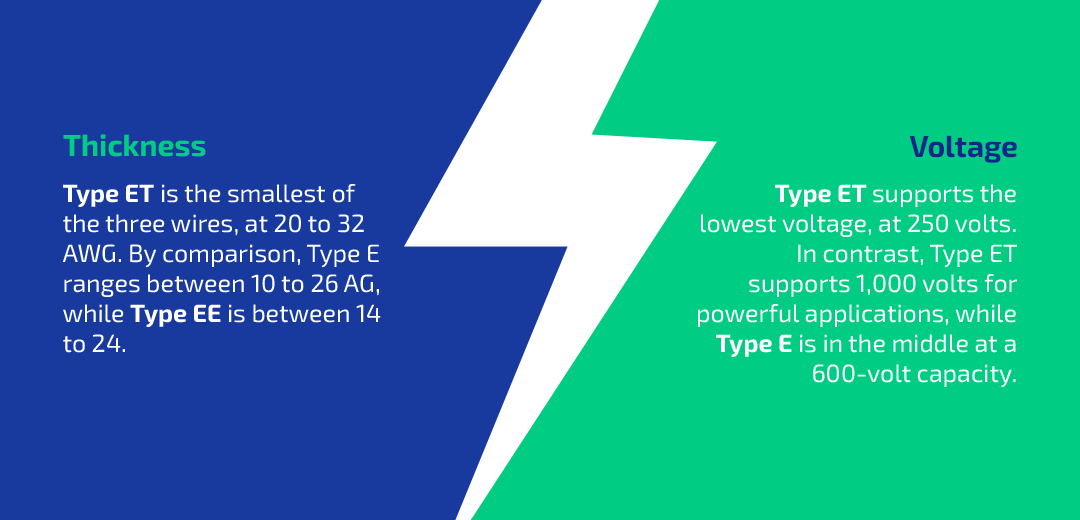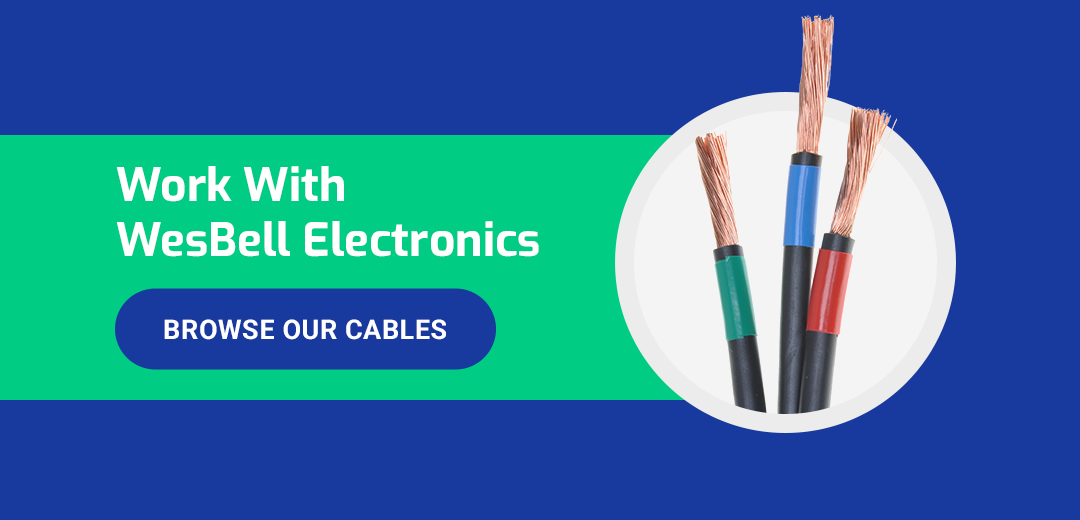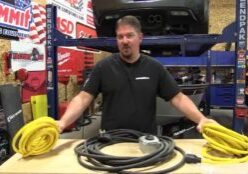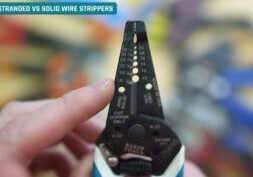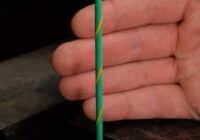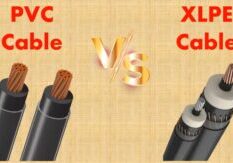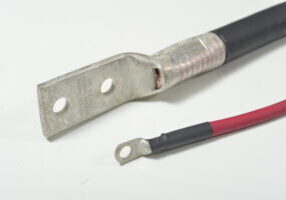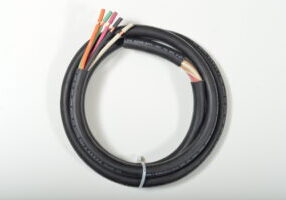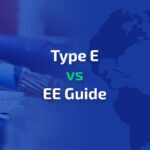
Jun 18, 2024
Type E vs. EE Guide
Industrial and specialized applications frequently need Type E and EE wires for their robust, flexible properties. Both wire types have outstanding resistance to heat and chemicals, excelling in challenging conditions. Type EE offers even more durability and longevity with its additional insulation layer. This guide will explore these wire types, including their specifications, standards and applications, to help you choose which to use for your project.
What Is Type EE Wire?
Type EE wire is part of a broad class of hookup wire made of polytetrafluoroethylene, also known as Teflon. Its additional layer of insulation and PTFE make it resistant to many chemicals and heat up to 200 degrees Celsius. WesBell Electronics sells 1,000-volt Type EE wire — available in American Wire Gauge sizes 14, 16, 18, 20, 22 and 24.
With its extreme temperature resistance, Type EE makes a trustworthy solution for various applications and projects.
- Military wiring: Type EE wire resists high temperatures in military environments, often used in vehicles or aircraft, where durability and protection are essential.
- Internal appliance wiring: Manufacturers may use Type EE wire in internal appliances for parts that generate heat or encounter high temperatures, such as ovens or industrial machinery. The wiring can withstand these challenging conditions for better longevity.
- Device manufacturing: In device manufacturing, Type EE wire offers insulation, durability and consistency for devices used in demanding environments and constantly changing conditions.
- Power supply lead wires: Type EE wire provides enhanced protection against abrasion and chemicals, ensuring reliable power transmission in units that could be subject to challenging operating conditions.
- Medical electronics: Type EE is ideal for devices like medical electronics that rely on high conduction capabilities. The wire may enhance protection against wear and tear, ensuring better performance for medical equipment that sees frequent use.
Specifications and Standards
Due to its exceptional quality, many credible applications rely on Type EE wire. The third parties that have offered approval for Type EE wire include:
- Military Specification M16878/5
- CSA Group
- UL1180
- Restriction of Hazardous Substances directive
What Is Type E Wire?
Type E wire is within the hookup wire category, featuring PTFE insulation that makes it durable, versatile and highly damage-resistant. The flexible wire also comes in various AWG sizes, making it beneficial in many diverse applications. Like Type EE, Type E wire uses PTFE, with a jacket rated at 200 degrees Celsius. It supports 600 volts, ranging in AWG sizes from 14 to 26.
Due to its moderate insulation thickness, Type E wire is beneficial in indoor and outdoor applications that call for high temperature resistance. It can withstand oil, solvents, grease, fungus and chemicals. You can also submerge it in liquids, gasoline vapor and oils without degradation. With its low-friction surface, you can easily handle the wire and protect it against ozone and weathering.
Specifications and Standards
This type of wire complies with various third-party specifications and standards, such as:
- Restriction of Hazardous Substances directive
- Military Specification 16878/4
- CSA Group
- UL, LLC
Type EE vs. Type ET and Type E
Type E, Type EE and Type ET are similar types of hookup wire. With a PTFE coating and silver-plated copper strands, all three offer the same basic construction. Each is chemically resistant and supports temperature ratings of minus 60 degrees Celsius to 200 degrees Celsius. They differ in thickness and voltage capabilities.
- Thickness: Type ET is the smallest of the three wires, at 20 to 32 AWG. By comparison, Type E ranges between 10 to 26 AG, while Type EE is between 14 to 24.
- Voltage: Type ET supports the lowest voltage, at 250 volts. In contrast, Type ET supports 1,000 volts for powerful applications, while Type E is in the middle at a 600-volt capacity.
These wires offer high resistance to stress, chemicals, UV radiation, thermal aging and fire. They are also smaller and lighter than wires with other insulation types. Their voltage differences allow each wire to meet specific insulation and voltage requirements for various applications while offering similar high environmental resistance.
Application Considerations
Consider the following application-specific factors to determine whether Type E or Type EE wire suits your project requirements.
- Temperature range: You should know your application’s temperature range to choose the correct wire type. For instance, Type E wire is excellent for industrial machinery, as it offers excellent heat, oil and chemical resistance. At the same time, Type EE wire provides additional heat resistance with its extra insulation layer, making it ideal for ovens or industrial furnaces. In the automotive industry, you will find it in wiring harnesses that are often subject to high heat.
- Flexibility needs: Consider your flexibility requirements for installation and operation. Type E wire is ideal fo power generation applications due to its extreme flexibility and durability.
- Cost: Type EE wire tends to be more expensive because of the additional insulation layer and resistance. If you don’t have high temperature or chemical resistance needs, you may consider Type E wire as the more cost-effective option for your project.
- Chemical resistance: Consider whether your wire needs to resist exposure to certain chemicals or oils. While Type E has moderate resistance to chemicals, Type EE wire will generally provide better chemical resistance since it has an extra insulation layer. If you require more chemical resistance, Type EE wire would likely be the better choice, especially in environments with more aggressive chemicals like chemical processing plants or manufacturing facilities.
- Abrasion resistance: Type EE wire might be the better fit if your application involves conditions where abrasion is common, such as outdoor installations or industrial machinery. That’s due to its additional insulation layer, making it ideal for wire prone to mechanical wear and tear.
While Type E wire is more flexible and affordable, Type EE has a higher temperature rating and resistance to abrasion and chemicals. You’ll want to consider the above factors to choose the best wire for your application.
Work With WesBell Electronics
Type E and EE wire offer various benefits for multiple applications, from military wiring and medical electronics to industrial equipment. WesBell Electronics carries Type E, Type EE, Type ET and many other types of hookup wire. We’ll help you sort through these options to assess your performance and budget needs.
In addition to cabling, we provide wire preparation services, ensuring the wires are ready for work as soon as they reach you. Our experts look forward to helping you with your wire and cabling needs. Browse our cables or reach out to our knowledgeable team if you have any questions.

